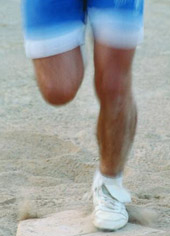 |
You spend hours and hours in the gym. Your friends and family, prone to exaggeration, think that you have a little cot in the back of the gym and all your favourite fitness quotes tacked on the wall. You spend all your free time sitting on the stationary bike and your nights in applying baby powder to your chafed thighs. But you are still far away from your fitness goal. This could be your story or your neighbour’s. In other words, it’s a common fate.
If, however, you want to pep up your exercise regimen, ask your instructor to give you a new approach to the same old stuff you are doing — let’s talk about interval training. This is something that will keep you interested in pedalling the bike and be more effective than low-intensity endurance training. Walk into the world of high-intensity interval training (HIIT). “The premise is simple: rather than waste time exercising at a slow pace, you alternate intervals of moderate-intensity exercise with periods of near-maximum effort,” says Ranadeep Moitra, fitness trainer of Bengal and India A cricket teams. “But don’t jump for it. If you are a starter or you have health problems, then check carefully, with your doctor and your instructor, before starting on a programme like this,” he cautions.
HIIT Fact Sheet
Before you even think of HIIT, work a little backwards. Determine your fitness objective: Do you have a close end (result-specific programme) — clear-cut, measurable fitness goals with definite timeframes for achievement? Your goal could be anything from reducing fat to preparing for a sprinting event. Or do you have an open-ended, general fitness programme, which characterises 90 per cent of the workouts that take place in the home and health clubs today?
Depending on the answer, your instructor should be able to tell you if you need HIIT — and if you can handle it. “It is prudent to point out that those with a low-fitness level (due to a sedentary lifestyle or low functional capacity) may not be able to perform at high intensities for a long duration. You need some foundation work for this,” warns Moitra.
uHIIT speeds up your metabolism and keeps it revved up for some time after the workout. The bottomline is that it burns a greater number of calories than low-intensity training. So if you want a workout that can propel you to the next fitness level, burn more calories, increase your speed, improve your power, etc., then it’s time you learn more about this technique.
uTo begin with, choose a type of exercise: walking, jogging, swimming, biking, etc. Next, determine your lower-intensity level. This is usually somewhere between 50-65 per cent of your target heart rate (which differs from person to person and is decided by your fitness instructor). This will be your baseline. Then simply increase the intensity to the level where you feel like you are working hard to very hard, but avoid reaching a level over 85 per cent of the target heart rate. You may choose to systematically raise and lower your intensity (for example, two minutes of lower intensity followed by one minute of higher intensity and repeat) or you can alternate more randomly by raising or lowering the level at your discretion. But it’s always advisable to have your instructor by your side.
uIn its most basic form, HIIT might involve walking for two minutes, followed by running for two minutes. Next, you can do some brisk walking and then run for three minutes. The intensity of each interval is up to how you feel and what you are trying to achieve. The same is true for the length of each interval. For example, if you are in the habit of walking two kilometres a day in 30 minutes, you can easily increase the intensity of your walk by picking up the pace every few minutes and then returning to the usual. A great trick is to tell yourself that you’ll run a particular distance (say, from the blue car to the green house in the corner) and then walk a bit (say, from the green house to the next telephone pole).
uHIIT utilises the body’s two energy-producing systems: aerobic and anaerobic. The aerobic system is the one that allows you to walk or run several miles; the anaerobic, on the other hand, draws energy from the muscles for short bursts of activity, such as sprinting, jumping or lifting weights. The latter system, however, does not provide energy for more than 2-3 minutes, and its by-product, lactic acid, is responsible for the achy, burning sensation in our muscles that we feel after, say, running up several flights of stairs. HIIT enables our body to perform activities, which are supported by the anaerobic system. So if you are going for a race, switch to HIIT. It will give you the strength to cover the last 200 metres at nearly double the original speed. If you are not into sports, let’s just say that HIIT will help you climb to the fifth floor of your office building while others are happy waiting for the elevator.











